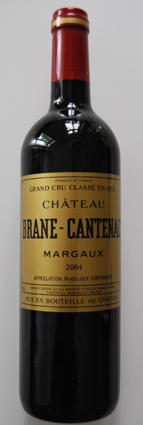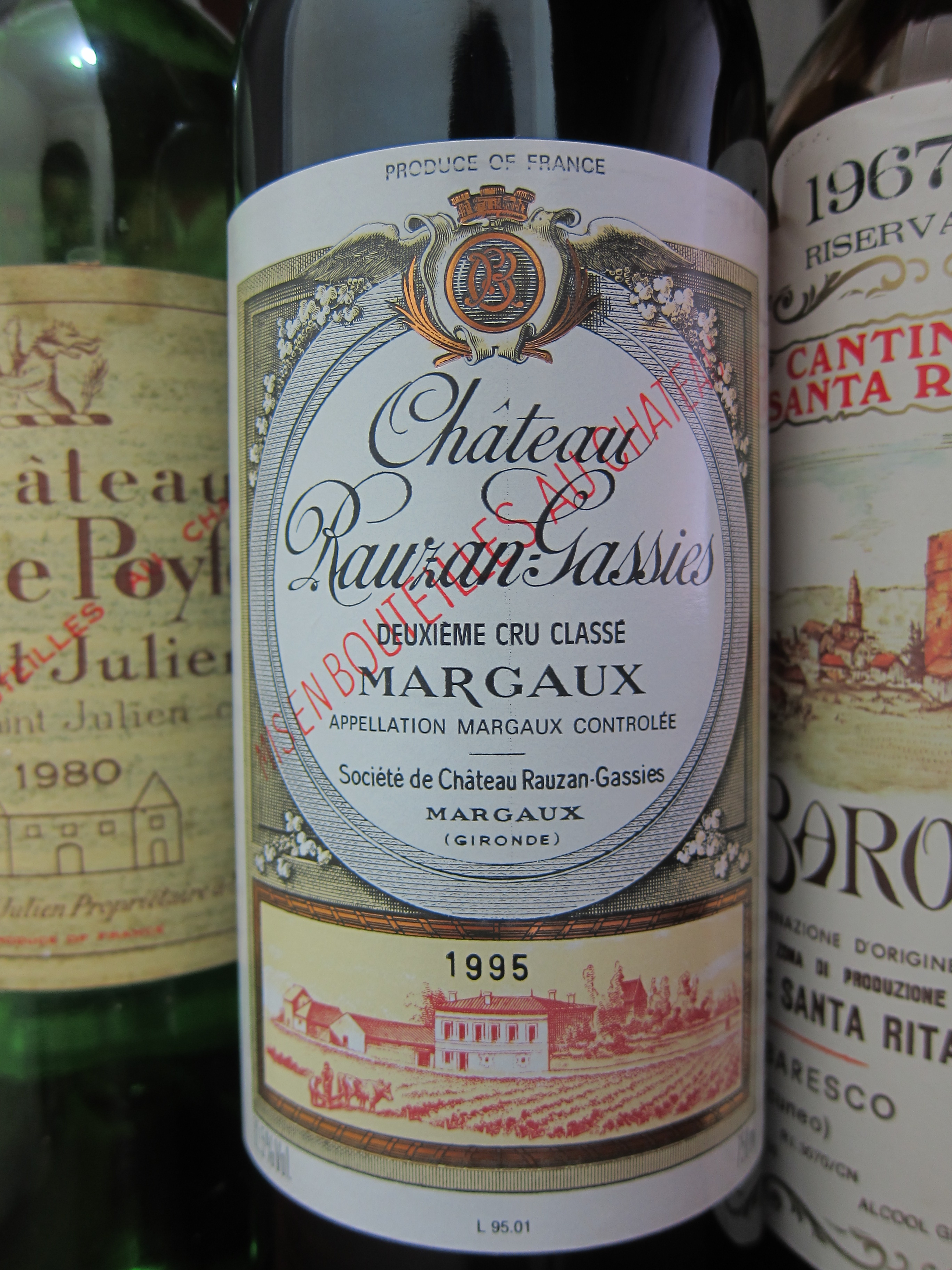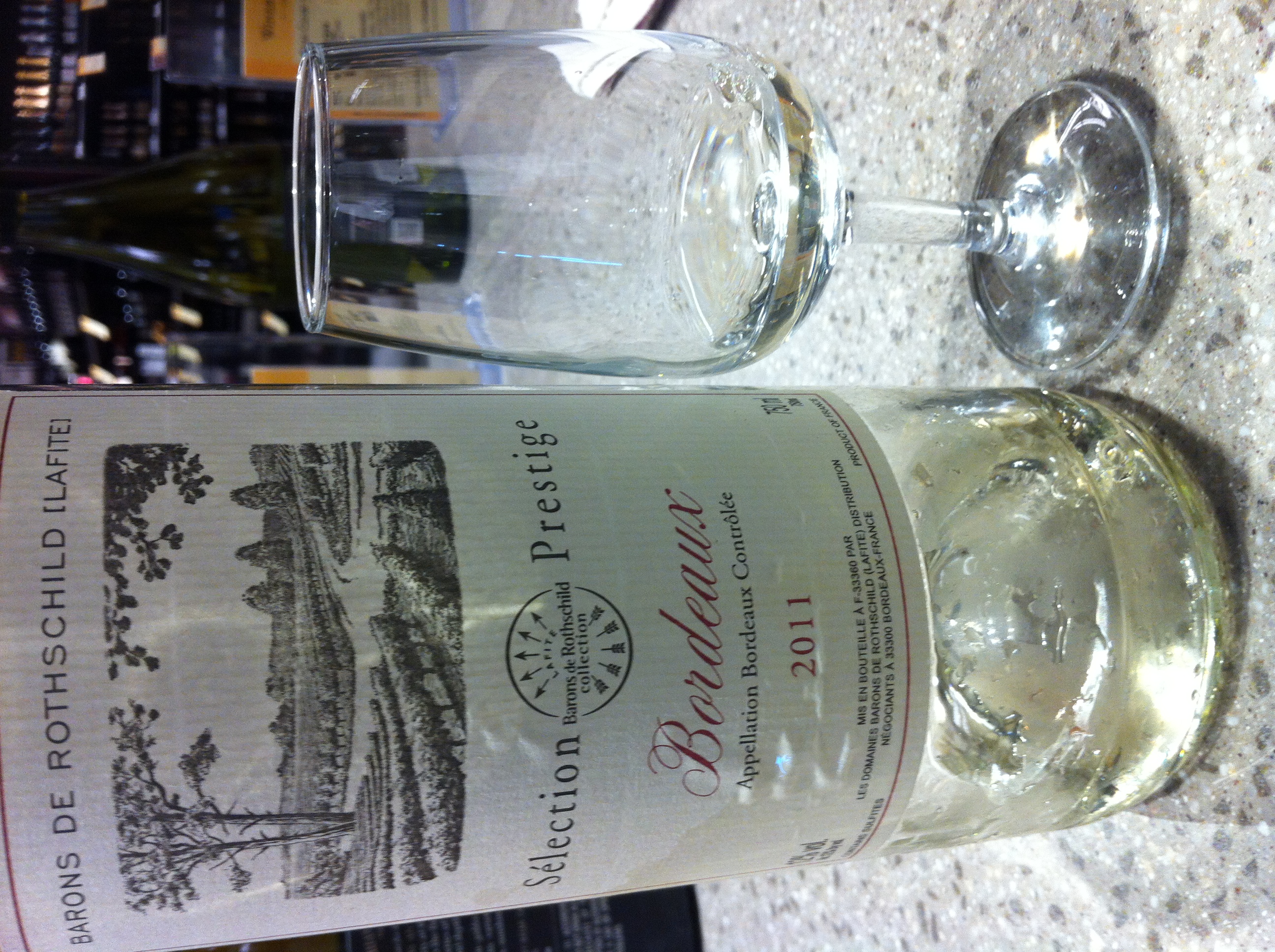|
Margaux AOC
Margaux is a wine growing commune and Appellation d'origine contrôlée within Haut-Médoc in Bordeaux, centred on the village of Margaux. Its leading (''premier cru'') château is also called Margaux. It contains 21 cru classé châteaux, more than any other commune in Bordeaux. Geography As well as Margaux itself, the ''appellation'' includes the villages of Cantenac, Arsac, Soussans and Labarde. It is on the left bank of the Gironde. It is the southernmost ''appellation'' in the Médoc (the ''haut'' in ''Haut-Médoc'' refers to the fact that it lies upstream), not far north of Bordeaux itself. To the east is the Landes forest. The soil is the thinnest in the ''Médoc'', with the highest proportion of gravel. (The generally perceived opinion being that poor soil makes good wine.) The gravel provides good drainage. The forest to the west shelters the vines from Atlantic breezes. Margaux contains 1413 hectares of vineyards, making it the second largest ''appellation'' ... [...More Info...] [...Related Items...] OR: [Wikipedia] [Google] [Baidu] |
Appellation D'origine Contrôlée
An appellation is a legally defined and protected geographical indication primarily used to identify where the grapes for a wine were grown, although other types of food often have appellations as well. Restrictions other than geographical boundaries, such as what grapes may be grown, maximum grape yields, alcohol level, and other quality factors may also apply before an appellation name may legally appear on a wine bottle label. The rules that govern appellations are dependent on the country in which the wine was produced. History The tradition of wine appellation is very old. The oldest references are to be found in the Bible, where ''wine of Samaria'', ''wine of Carmel'', ''wine of Jezreel'', or ''wine of Helbon'' are mentioned. This tradition of appellation continued throughout the Antiquity and the Middle Ages, though without any officially sanctioned rules. Historically, the world's first exclusive (protected) vineyard zone was introduced in Chianti, Italy in 1716 and th ... [...More Info...] [...Related Items...] OR: [Wikipedia] [Google] [Baidu] |
Merlot
Merlot is a dark blue–colored wine grape variety, that is used as both a blending grape and for varietal wines. The name ''Merlot'' is thought to be a diminutive of ''merle'', the French name for the blackbird, probably a reference to the color of the grape. Its softness and "fleshiness," combined with its earlier ripening, make Merlot a popular grape for blending with the sterner, later-ripening Cabernet Sauvignon, which tends to be higher in tannin. Along with Cabernet Sauvignon, Cabernet Franc, Malbec and Petit Verdot, Merlot is one of the primary grapes used in Bordeaux wine, and it is the most widely planted grape in the Bordeaux wine regions. Merlot is also one of the most popular red wine varietals in many markets. This flexibility has helped to make it one of the world's most planted grape varieties. As of 2004, Merlot was estimated to be the third most grown variety at globally.J. Robinson (ed) ''The Oxford Companion to Wine'' Third Edition, Oxford University Pre ... [...More Info...] [...Related Items...] OR: [Wikipedia] [Google] [Baidu] |
Château D'Issan
Château d'Issan is a castle and winery in the Margaux appellation of the Bordeaux region of France. The wine produced here was classified as one of fourteen ''Troisièmes Crus'' (Third Growths) in the historic Bordeaux Wine Official Classification of 1855. The winery is under the proprietorship of Emmanuel Cruse, of the Cruse family. In February 2013, 50% of the estate was purchased by Jacky Lorenzetti, who also owns Château Pédesclaux in Pauillac & Chateau Lilian Ladouys in Saint-Estèphe. retrieved 25 March 2014 Production The vineyard abuts other Margaux châteaux, including Château Palmer and Château Margaux itself, in separate lots totalling . The grape varieties cultivated are 62% Cabernet Sauvignon, 38% Merlot. Producing annually 6,000 cases of the ''Grand vin'', d'Issan also makes a second wine Second wine or second label ( French: ''Second vin'') is a term commonly associated with Bordeaux wine to refer to a second label wine made from '' cuvee'' not sele ... [...More Info...] [...Related Items...] OR: [Wikipedia] [Google] [Baidu] |
Château Kirwan
Château Kirwan is a winery in the Margaux appellation of the Bordeaux region of France. The wine produced here was classified as one of fourteen ''Troisièmes Crus'' (Third Growths) in the historic Bordeaux Wine Official Classification of 1855. Its second wine is called Les Charmes de Kirwan. Vineyards Château Kirwan has of vineyards, planted to 45% Cabernet Sauvignon, 30% Merlot, 15% Cabernet Franc, and 10% Petit Verdot. , accessed 2012-09-09 The Tribes of Galway The Kirwan family were one of theTribes of Galway
The Tribes of Galway ( ga, Treibheanna na Gaillimhe) were 14 merchant families who dominated the political ...
[...More Info...] [...Related Items...] OR: [Wikipedia] [Google] [Baidu] |
Château Brane-Cantenac
Château Brane-Cantenac is a winery in the Margaux appellation of the Bordeaux wine region of France. The wine produced here was classified as one of fifteen ''Deuxièmes Crus'' (Second Growths) in the original Bordeaux Wine Official Classification of 1855. The estate also produces a second wine named Baron de Brane, a label named Château Notton, and a generic Margaux. History Previously a reputed estate named Château Gorce (sometimes recorded as Gorse), its wine was sold at high prices and was listed as a second growth in pre-1855 classifications such as '' Cocks & Féret''. It was acquired in 1833 by Baron Hector de Branne, termed the "Napoléon of the Vines", who named the estate after himself, a bold gesture for that period. Having once also owned the land that today is Château Mouton Rothschild, the sale of Château Brane-Mouton helped finance the purchase of this estate. With the Baron's total devotion to the vineyard, the wine was estimated to be the finest produced i ... [...More Info...] [...Related Items...] OR: [Wikipedia] [Google] [Baidu] |
Château Lascombes
Château Lascombes is a winery in the Margaux appellation of the Bordeaux region of France. The wine produced here was classified as one of fifteen ''Seconds Crus'' (Second Growths) in the original Bordeaux Wine Official Classification of 1855. In the 1950s, the estate was purchased by French wine writer Alexis Lichine who continued to own part of the estate till 1971 when Bass Charrington took over principal ownership. In 2001 it was purchased by Yves Vatelot and US-based Colony Capital, who in 2011 sold it to the French insurance group MACSF. In addition to its premier '' cuvee'', a second wine is also produced, under the name Chevalier de Lascombes. Additional brands are Château Segonnes, Rosé de Lascombes, Vin Sec Chevalier de Lascombes and Gombaud.T. Stevenson ''"The Sotheby's Wine Encyclopedia"'' pg 95 Dorling Kindersley 2005 History In the 17th century the estate belonged to Antoine, chevalier de Lascombes, and has kept his name. Some locals suggest the estate, wh ... [...More Info...] [...Related Items...] OR: [Wikipedia] [Google] [Baidu] |
Château Durfort-Vivens
Château Durfort-Vivens is a winery in the Margaux Appellation d'Origine Contrôlée, appellation of the Bordeaux wine, Bordeaux region of France. It is also the name of the red wine produced by this property. The wine produced here was classified as one of fifteen ''Deuxièmes Crus'' (Second Growths) in the original Bordeaux Wine Official Classification of 1855. While the 1855 classification is still legally in effect, more modern classifications have been performed to reconcile changes over time. In The Liv-ex Bordeaux Classification, in which quality of Bordeaux red wine is determined by demand in terms of price, Château Durfort-Vivens is listed as a Fifth Growth. In Alexis Lichine's classification of Bordeaux wine, which is based on subjective criteria, it is a ''Grand Cru'' (Great Growth), putting it in the third group on his list. History The Durfort property dates back to the 12th century having been owned by the influential Durfort de Duras family for seven centurie ... [...More Info...] [...Related Items...] OR: [Wikipedia] [Google] [Baidu] |
Château Rauzan-Gassies
Château Rauzan-Gassies is a winery in the Margaux appellation of the Bordeaux region of France. Château Rauzan-Gassies is also the name of the red wine produced by this property. The wine produced here was classified as one of fifteen ''Deuxièmes Crus'' (Second Growths) in the original Bordeaux Wine Official Classification of 1855. History The domain began as the property of Gaillard de Tardes in the 16th century, and belonged to Bernard de Baverolles in the 17th century, and came to be a part of the vast Rauzan estate owned by Pierre de Mesures de Rauzan in the 18th century. Over time this estate was divided, and by the time of the 1855 Classification, had been separated into the estates of Rauzan-Gassies, Château Rauzan-Ségla, Château Desmirail, and Château Marquis de Terme. The estate was purchased by the Quié family in 1945 and remains in their holdings. Production Château Rauzan-Gassies consists of of vines,Kissack, Chris, thewinedoctor.coChateau Rauzan-Gas ... [...More Info...] [...Related Items...] OR: [Wikipedia] [Google] [Baidu] |
Château Rauzan-Ségla
Château Rauzan-Ségla, or Château Rausan-Ségla, is a winery in the Margaux appellation of the Bordeaux region of France. Château Rauzan-Ségla is also the name of the red wine produced by this property. The wine produced here was classified as one of fifteen ''Deuxièmes Crus'' (Second Growths) in the original Bordeaux Wine Official Classification of 1855. The alternate name "Rausan-Ségla" was also frequently used until 1994 when the original "Rauzan-Ségla" again became the official name. History Rauzan-Ségla was once part of the vast Rauzan estate owned by Pierre de Mesures de Rauzan in the mid-17th century. Over time, this estate was divided, and by the time of the 1855 Classification, had been separated into the estates of Château Rauzan-Gassies, Château Rauzan-Ségla, Château Desmirail, and Château Marquis de Terme. After a long ownership by the Durand-Dasier family, the estate was acquired by Frédéric Cruse of the Cruse family in 1903 who held ownership ... [...More Info...] [...Related Items...] OR: [Wikipedia] [Google] [Baidu] |
Regional Bordeaux AOCs
In the Bordeaux wine region there are seven regional '' Appellations d'origine contrôlée'' (AOCs) that may be used throughout the Gironde department. These are Bordeaux Rouge AOC, Bordeaux Supérieur Rouge, Bordeaux Clairet, Bordeaux Rosé, Bordeaux Blanc, a dry white, Bordeaux Supérieur Blanc, a sweet white, and ''Crémant de Bordeaux'', a sparkling méthode traditionnelle wine. The regional appellations together form the largest world-class wine vineyard, making up more than half of the production of the prestigious Bordeaux wine region, and representing more than 55% of all Bordeaux wines consumed in the world. Bordeaux AOC Wine style The entry-level Bordeaux AOC reds are fruity and easy-to-drink, and meant for early consumption rather than cellaring. More ambitious reds are usually sold as Bordeaux Supérieur AOC. Notable exceptions to the general rule of Bordeaux AOC as simpler wines are some dry white wines produced in Médoc and Sauternes, where the production of r ... [...More Info...] [...Related Items...] OR: [Wikipedia] [Google] [Baidu] |
Médoc AOC
Médoc is an AOC for wine in the Bordeaux wine region of southwestern France, on the Left Bank of the Gironde estuary that covers the northern section of the viticultural strip along the Médoc peninsula. The zone is sometimes called Bas-Médoc ( en, Low-Médoc), though this term is not permitted on any label. With few exceptions there is produced only red wine, and no white wine has the right to be called Médoc. The term Médoc is often used in a geographical sense to refer to the whole Left Bank region, and as defined by the original Institut National des Appellations d'Origine (INAO) decree of November 14, 1936, the appellation may be applied to all wine produced in the prescribed zone in the peninsula, but this is rare practice by estates within Médoc's sub-appellations as it carries lesser perceived prestige. Effectively it covers the northern third of the Médoc peninsula, defined by a border that runs from Saint-Yzans and Saint-Germain-d'Esteuil (at the northern edges ... [...More Info...] [...Related Items...] OR: [Wikipedia] [Google] [Baidu] |
Malbec
Malbec () is a purple grape variety used in making red wine. The grapes tend to have an inky dark color and robust tannins, and are known as one of the six grapes allowed in the blend of red Bordeaux wine. In France, plantations of Malbec are now found primarily in Cahors in South West France, though the grape is grown worldwide. It is increasingly celebrated as an Argentine varietal. The grape became less popular in Bordeaux after 1956 when frost killed off 75% of the crop. Despite Cahors being hit by the same frost, which devastated the vineyards, Malbec was replanted and continued to be popular in that area. Winemakers in the region frequently mixed Malbec with Merlot and Tannat to make dark, full-bodied wines, but have ventured into 100% Malbec varietal wines more recently.J. Robinson ''Vines, Grapes & Wines'' pg 198 & 204 Mitchell Beazley 1986 A popular but unconfirmed theory claims that Malbec is named after a Hungarian peasant who first spread the grape variety throu ... [...More Info...] [...Related Items...] OR: [Wikipedia] [Google] [Baidu] |




